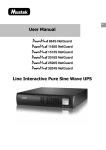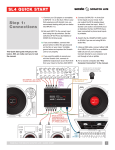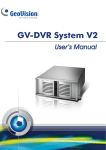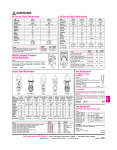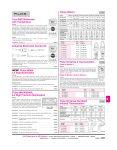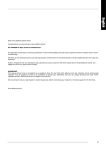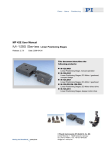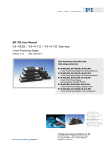Download Mustek POWERMUST 2520S NETGUARD User manual
Transcript
User Manual PowerMust 864/1188/1512/2016/2520/ 3024S NetGuard Uninterruptible Power Supply System Table of Contents 1. Important Safety Warning……………………………………………… 1-1. Transportation 1-2. Preparation 1-3. Installation 1-4. Operation 1-5. Maintenance, Service And Faults 2 2 2 2 2 3 2. Installation And Setup…………………………………………………… 2-1. Rear Panel View 2-2. Install The UPS 2-3. Setup The UPS 2-4. Battery Replacement 4 4 5 6 7 3. Operations………………………………………………………………….. 3-1. Button Operation 3-2. LCD Panel 3-3. Audible Alarm 3-4. LCD Display Wordings Index 3-5. UPS Setting 3-6. Operating Mode Description 3-7. Faults Reference Code 3-8. Warning Indicator 8 8 8 9 10 10 12 13 13 4. Troubleshooting…………………………………………………………... 14 5. Storage And Maintenance………………………………………………. 16 6. Specifications……………………………………………………………… 17 1 1. Important Safety Warning Please comply with all warnings and operating instructions in this manual strictly. Save this manual properly and read carefully the following instructions before installing the unit. Do not operate this unit before reading through all safety information and operating instructions carefully 1-1. Transportation Please transport the UPS system only in the original package to protect against shock and impact. 1-2. Preparation Condensation may occur if the UPS system is moved directly from cold to warm environment. The UPS system must be absolutely dry before being installed. Please allow at least two hours for the UPS system to acclimate the environment. Do not install the UPS system near water or in moist environments. Do not install the UPS system where it would be exposed to direct sunlight or near heater. Do not block ventilation holes in the UPS housing. 1-3. Installation Do not connect appliances or devices which would overload the UPS system (e.g. laser printers) to the UPS output sockets. Place cables in such a way that no one can step on or trip over them. Do not connect domestic appliances such as hair dryers to UPS output sockets. The UPS can be operated by any individuals with no previous experience. Connect the UPS system only to an earthed shockproof outlet which must be easily accessible and close to the UPS system. Please use only VDE-tested, CE-marked mains cable (e.g. the mains cable of your computer) to connect the UPS system to the building wiring outlet (shockproof outlet). Please use only VDE-tested, CE-marked power cables to connect the loads to the UPS system. When installing the equipment, it should ensure that the sum of the leakage current of the UPS and the connected devices does not exceed 3.5mA. 1-4. Operation Do not disconnect the mains cable on the UPS system or the building wiring outlet (shockproof socket outlet) during operations since this would cancel the protective earthing of the UPS system and of all connected loads. The UPS system features its own, internal current source (batteries). The UPS output sockets or output terminals block may be electrically live even if the UPS system is not connected to the building wiring outlet. In order to fully disconnect the UPS system, first press the OFF/Enter button to disconnect the mains. Prevent no fluids or other foreign objects from inside of the UPS system. 2 1-5. Maintenance, Service And Faults The UPS system operates with hazardous voltages. Repairs may be carried out only by qualified maintenance personnel. Caution - risk of electric shock. Even after the unit is disconnected from the mains (building wiring outlet), components inside the UPS system are still connected to the battery and electrically live and dangerous. Before carrying out any kind of service and/or maintenance, disconnect the batteries and verify that no current is present and no hazardous voltage exists in the terminals of high capability capacitor such as BUS-capacitors. Only persons are adequately familiar with batteries and with the required precautionary measures may replace batteries and supervise operations. Unauthorized persons must be kept well away from the batteries. Caution - risk of electric shock. The battery circuit is not isolated from the input voltage. Hazardous voltages may occur between the battery terminals and the ground. Before touching, please verify that no voltage is present! Batteries may cause electric shock and have a high short-circuit current. Please take the precautionary measures specified below and any other measures necessary when working with batteries: remove wristwatches, rings and other metal objects use only tools with insulated grips and handles. When changing batteries, install the same number and same type of batteries. Do not attempt to dispose of batteries by burning them. This could cause battery explosion. Do not open or destroy batteries. Escaping electrolyte can cause injury to the skin and eyes. It may be toxic. Please replace the fuse only with the same type and amperage in order to avoid fire hazards. Do not dismantle the UPS system. 3 2. Installation And Setup NOTE: Before installation, please inspect the unit. Be sure that nothing inside the package is damaged. Please keep the original package in a safe place for future use. 2-1. Rear Panel View PowerMust 864/1188/1512/2016S NetGuard PowerMust 2520/3024S NetGuard 1. Programmable outlets: connect to non-critical loads. 2. Output receptacles: connect to mission-critical loads. 3. AC input 4. Input circuit breaker 5. Network/Fax/Modem surge protection 6. Emergency power off function connector (EPO) 7. USB communication port 8. RS-232 communication port 9. SNMP intelligent slot 10. Output circuit breaker 4 2-2. Install The UPS For safety consideration, the UPS is shipped out from factory without connecting battery wires. Before install the UPS, please follow below steps to re-connect battery wires first. Step 1 Step 2 Step 3 Remove front panel. Connect the AC input and re-connect battery wires. Rack-mount Installation Step 1 Tower Installation Step 1 Put the front panel back to the unit. Step 2 Step 2 Step 3 5 2-3. Setup The UPS Step 1: UPS input connection Plug the UPS into a two-pole, three-wire, grounded receptacle only. Avoid using extension cords. Step 2: UPS output connection For socket-type outputs, there two kinds of outputs: programmable outlets and general outlets. Please connect non-critical devices to the programmable outlets and critical devices to the general outlets. During power failure, you may extend the backup time to critical devices by setting shorter backup time for non-critical devices. Step 3: Communication connection Communication port: USB port RS-232 port Intelligent slot To allow for unattended UPS shutdown/start-up and status monitoring, connect the communication cable one end to the USB/RS-232 port and the other to the communication port of your PC. With the monitoring software installed, you can schedule UPS shutdown/start-up and monitor UPS status through PC. The UPS is equipped with intelligent slot perfect for either SNMP or AS400 card. When installing either SNMP or AS400 card in the UPS, it will provide advanced communication and monitoring options. PS. USB port and RS-232 port can’t work at the same time. Step 4: Network connection Network/Fax/Phone surge port Connect a single modem/phone/fax line into surge-protected “IN” outlet on the back panel of the UPS unit. Connect from “OUT” outlet to the equipment with another modem/fax/phone line cable. Step 5: Disable and enable EPO function Keep the pin 1 and pin 2 closed for UPS normal operation. To activate EPO function, cut the wire between pin 1 and pin 2. It’s in closed status for UPS normal operation. 6 Step 6: Turn on the UPS Press the ON/Mute button on the front panel for two seconds to power on the UPS. Note: The battery charges fully during the first five hours of normal operation. Do not expect full battery run capability during this initial charge period. Step 7: Install software For optimal computer system protection, install UPS monitoring software to fully configure UPS shutdown. Please follow steps below to download and install monitoring software: 1. Go to the website http://www.power-software-download.com 2. Click ViewPower software icon and then choose your required OS to download the software. 3. Follow the on-screen instructions to install the software. 4. When your computer restarts, the monitoring software will appear as an orange plug icon located in the system tray, near the clock. 2-4 Battery Replacement NOTICE: This UPS is equipped with internal batteries and user can replace the batteries without shutting down the UPS or connected loads.(hot-swappable battery design) Replacement is a safe procedure, isolated from electrical hazards. CAUTION!! Consider all warnings, cautions, and notes before replacing batteries. Note: Upon battery disconnection, equipment is not protected from power outages. Step 1 Step 2 Step 3 Remove front panel. Disconnect battery wires. Step 4 Step 5 Pull out the battery box by removing two screws on the front panel. Step 7 Remove the top cover of battery box and replace the inside batteries. After replacing the Re-connect the battery wires. batteries, put the battery box back to original location and screw it tightly. Step 8 Put the front panel back to the unit. 7 3. Operations 3-1. Button Operation Button ON/MUTE Button OFF/ENTER Button SELECT Button Function Turn on the UPS: Press and hold ON/Mute button for at least 2 seconds to turn on the UPS. Mute the alarm: After the UPS is turned on in battery mode, press and hold this button for at least 5 seconds to disable or enable the alarm system. But it’s not applied to the situations when warnings or errors occur. Up key: Press this button to display previous selection in UPS setting mode. Switch to UPS self-test mode: Press and hold ON/Mute button for 5 seconds to enter UPS self-testing while in AC mode Turn off the UPS: Press and hold this button at least 2 seconds to turn off the UPS Confirm selection key: Press this button to confirm selection in UPS setting mode. Switch LCD message: Press this button to change the LCD message for input voltage, input frequency, battery voltage, output voltage and output frequency. Setting mode: Press and hold this button for 5 seconds to enter UPS setting mode when UPS is off. Down key: Press this button to display next selection in UPS setting mode. 3-2. LCD Panel Rack Display Load info Input/output and Battery info UPS status Tower Display Battery info Battery info Warning & Fault info/ Setting operation Backup time info Load info 8 Input/output and Battery info Warning & Fault info/ Setting operation UPS status Backup time info Display Function Backup time information Indicates the backup time in pie chart. Indicates the backup time in numbers. H: hours, M: minute Warning & Fault information Indicates that the warning and fault occurs. Indicates the warning and fault codes, and the codes are listed in details in 3-5 section. Setting Operation Indicates the setting operation. Input/Output & Battery information Indicates the output/input voltage, output/input frequency or battery voltage. V: voltage, Hz: frequency Load information Indicates the load level by 0-25%, 26-50%, 51-75%, and 76-100%. Indicates overload. Indicates the load or the UPS output is short circuited. UPS status Indicates that programmable management outlets are working. Indicates that the UPS alarm is disabled. Indicates the UPS powers the output directly from the mains Indicates the battery charger is working. Indicates the UPS is working in boost mode Indicates the UPS is working in buck mode Battery information Indicates the Battery level by 0-25%, 26-50%, 51-75%, and 76-100%. Indicates low battery. Indicates there is something wrong with battery. 3-3. Audible Alarm Battery Mode Low Battery Overload Fault Sounding every 4 seconds Sounding every second Sounding twice every second Continuously sounding 9 3-4. LCD Display Wordings Index Abbreviation Display content Meaning ENA Enable DIS Disable ESC Escape EP EPO FA Fan TP Temperature CH Charger RAC Rack display TOE Tower display SF Site Fault 3-5. UPS Setting Parameters 2 There are two parameters to set up the UPS. Parameter 1: It’s for program alternatives. There are 4 programs to set up: output voltage setting, , programmable outlets enable/disable, programmable outlets setting , LCD display direction and exit. Parameters 1 01: Output voltage setting Interface Setting For 208/220/230/240 VAC models, you may choose the following output voltage: 208: presents output voltage is 208Vac 220: presents output voltage is 220Vac 230: presents output voltage is 230Vac 240: presents output voltage is 240Vac 02: Programmable outlets enable/disable Interface Setting ENA: Programmable outlets enable DIS: Programmable outlets disable 10 03: Programmable outlets setting Interface Setting Setting the backup time limits in minutes from 0-999 for programmable outlets which connect to non-critical devices on battery mode. 04: LCD display direction setting Interface Setting RAC: the LCD display is horizontal. TOE: the LCD display is vertical. 00: Exit setting Steps for setting programmable outlet Step 1: Before entering setting mode, the UPS should be in Stand-by mode (off-charging) and make sure the battery is connected. The LCD display is shown as right. Step 2: Press and hold the “Selection” button for 5 seconds to enter Setting mode. Step 3: Press the “Up“ button (ON/MUTE) to switch to "02" of program list. Then press “Enter“ button to enter value setting of parameter 2. Press the “Up” button to change the value to “ENA” to enable the programmable outlet function. Then press “Enter” button again to confirm the setting. 11 Step 4: Press the “Up“ button (ON/MUTE) again to switch to "03" of program list. Then press “Enter“ button for setting programmable outlet time. Push “Up” button to change the value of backup time according your demand. Then press “Enter” to confirm the setting. Step 5: Press “Up“ button (ON/MUTE) to switch to "00" of program list. Then press “Enter” button to exit setting menu. Step 6: Disconnect AC input and wait until the LCD display is off. The new setting will be activated when turning on the UPS again. 3-6. Operating Mode Description Operating mode Description ECO mode When the input voltage is within voltage regulated range, UPS will power the output directly from the mains. ECO is an abbreviation of Efficiency Corrective Optimizer. In this mode, when battery is fully charged, the fan will stop working for energy saving. Buck mode when AC is normal. When the input voltage is higher than the voltage regulation range but lower than high loss point, the buck AVR will be activated. Boost mode when AC is normal. When the input voltage is lower than the voltage regulation range but higher than low loss point, the boost AVR will be activated. Battery mode When the input voltage is beyond the acceptable range or power failure and alarm is sounding every 4 seconds, UPS will backup power from battery. 12 LCD display Operating mode Standby mode Description UPS is powered off and no output supply power, but still can charge batteries. 3-7. Faults Reference Code Fault event Fault code Bus start fail 01 Bus over 02 Bus under 03 Inverter soft start fail Inverter voltage high Inverter voltage Low 11 12 13 Icon x x x x x x LCD display Fault event Inverter output short Battery voltage too high Battery voltage too low Over temperature Over load Fault code 14 27 28 Icon 41 43 x x 3-8. Warning Indicator Warning Icon (flashing) Alarm Low Battery Sounding every second Overload Sounding twice every second Battery is not connected Sounding every second Overcharge Sounding every second Site wiring fault Sounding every second EPO enable Sounding every second Fan Failure Sounding every second Over temperature Sounding every second Charger failure Sounding every second Battery Fault Sounding every second 13 4. Troubleshooting If the UPS system does not operate correctly, please solve the problem by using the table below. Symptom Possible cause Remedy No indication and alarm even The AC input power is not Check if input power cord though the mains is normal. connected well. firmly connected to the mains. The AC input is connected Plug AC input power cord to to the UPS output. AC input correctly. The icon and the warning code flashing on LCD display and alarm is sounding every second. EPO function is activated. Line and neutral The icon and flashing on conductors of UPS input LCD display and alarm is sounding are reversed. every second. The external or internal The icon and flashing battery is incorrectly on LCD display and alarm is connected. sounding every second. Fault code is shown as 27 and the Battery voltage is too high or the charger is fault. Set the circuit in close position to disable EPO function. Rotate mains power socket by 180° and then connect to UPS system. Check if all batteries are connected well. Contact your dealer. icon is lighting on LCD display and alarm is continuously sounding. Fault code is shown as 28 and the Battery voltage is too low Contact your dealer. or the charger is fault. is lighting on LCD display icon and alarm is continuously sounding. The icon and the icon are flashing on LCD display and alarm is sounding twice every second. Fault code is shown as 43 and The icon is lighting on LCD display and alarm is continuously sounding. Fault code is shown as 14 and alarm is continuously sounding. UPS is overload Remove excess loads from UPS output. The UPS shut down automatically because of overload at the UPS output. The UPS shut down automatically because short circuit occurs on the UPS output. Remove excess loads from UPS output and restart it. 14 Check output wiring and if connected devices are in short circuit status. Symptom Fault code is shown as 1, 2, 3, 4, 11, 12, 13 and 41 on LCD display and alarm is continuously sounding. Battery backup time is shorter than nominal value Possible cause Remedy A UPS internal fault has Contact your dealer occurred. Batteries are not fully charged Batteries defect The icon and the warning code flashing on LCD display Fan is locked or not working and alarm is sounding every second. 15 Charge the batteries for at least 5 hours and then check capacity. If the problem still persists, consult your dealer. Contact your dealer to replace the battery. Check fans and notify dealer!! 5. Storage and Maintenance 5-1. Operation The UPS system contains no user-serviceable parts. If the battery service life (3~5 years at 25°C ambient temperature) has been exceeded, the batteries must be replaced. In this case, please contact your dealer. Be sure to deliver the spent battery to a recycling facility or ship it to your dealer in the replacement battery packing material. Storage Before storing, charge the UPS 5 hours. Store the UPS covered and upright in a cool, dry location. During storage, recharge the battery in accordance with the following table: Storage Temperature Recharge Frequency Charging Duration -25°C - 40°C Every 3 months 1-2 hours 40°C - 45°C Every 2 months 1-2 hours 16 6. Specifications MODEL CAPACITY PM 848S Netguard 800 VA / 640 W PM 1188S Netguard 1100 VA / 880 W PM 1512S Netguard 1500 VA / 1200 W PM 2016S Netguard 2000 VA / 1600 W PM 2520S Netguard 2500 VA / 2000 W PM 3024S Netguard 3000 VA / 2400 W INPUT Acceptable Voltage Range 81-145 VAC or 162-290 VAC Frequency Range 60/50 Hz (auto sensing) OUTPUT Voltage Regulation (AC Mode) Voltage Regulation (Batt. Mode) Frequency Range (Batt. Mode) 110/120 VAC or 208/220/230/240 VAC ±3%(before battery alarm) 50 Hz or 60 Hz ± 1 Hz Current Crest Ratio 3:1 Harmonic Distortion 8% max @ 100% linear load, 15% max @ 100% non-linear load (before alarm) Transfer Time Typical 2-6 ms, 10ms max. Waveform (Batt. Mode) Pure Sine Wave EFFICIENCY AC Mode 97% 97% 97% Buck & Boost Mode 90% 90% 90% Battery Mode 83% 85% 87% BATTERY Battery Type & Number Charging Voltage 12 V/7 Ah x 2 12 V/9 Ah x 2 12 V/7 Ah x4 27.4 VDC ± 1% 12 V/9 Ah x4 12 V/7 Ah x6 54.8 VDC ± 1% Typical Recharge Time 12 V/9 Ah x6 82.1 VDC ± 1% 4 hours recover to 90% capacity PROTECTION Full Protection Overload, short, discharge, and overcharge protection ALARM Battery Mode Sounding every 10 seconds Low Battery Sounding every second Overload Sounding every 0.5 second Battery Replacement Alarm Sounding every second Fault Continuously sounding PHYSICAL Dimension, DXWXH (mm) Net Weight (kg) ENVIRONMENT Standard Model Operating Humidity 350 x 438 x 88 14.8 480 x 438 x 88 15.8 23 600 x 438 x 88 25 32 0-90 % RH @ 0- 40°C (non-condensing) Noise Level Less than 45dB MANAGEMENT Smart RS-232/USB Optional SNMP Supports Windows® 2000/2003/XP/Vista/2008, Windows® 7, Linux, Unix, and MAC Power management from SNMP manager and web browser * Derate capacity to 80% of capacity when the output voltage is adjusted to 208VAC. **Product specifications are subject to change without further notice. 17 35


















